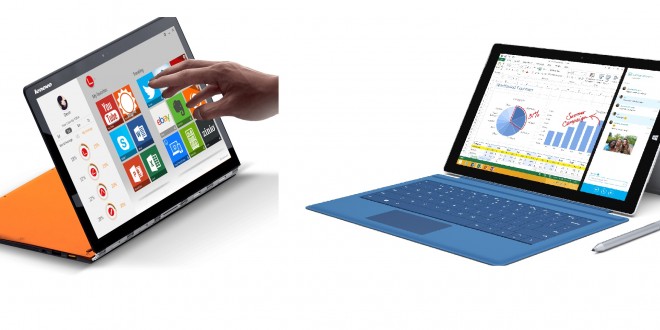While convertibles aren’t that popular yet, many companies have begun releasing them because they are a great alternative to carrying two different gadgets around. With the Microsoft Surface Pro 3 or the Lenovo Yoga 3 Pro, you have a combination of two devices: a tablet and a laptop in one. The advantage of convertibles like the Surface Pro 3 is that you have less weight and gear to carry around, you can use the device in various modes and it has full desktop integration thanks to Windows 8.1. While there already are many convertibles to choose from, including the Asus Transformer Book T100, Surface Pro 2, Lenovo Yoga 2 Pro and many others, the two latest devices in this category are the Surface Pro 3 and Lenovo Yoga 3 Pro. This short comparison will try to illustrate which would suit what kind of user and why one would be the better choice than the other.
First off, the whole idea of a convertible inherently pleases me, so I probably am biased towards this category of devices. But since we’re talking about two convertibles, the Surface Pro 3 and Lenovo Yoga 3 Pro, my biased nature should be more of an asset than an issue. In any case, there are many advantages to owning a convertible, but price isn’t one. Convertibles tend to be as expensive as full-blown laptops, but mostly because they encompass two different devices in one – a tablet and a notebook. If you are wondering how that would be possible, the premises is simple: detachable keyboard and a touchscreen.
Convertibles are slowly becoming the popular kind of office gear because they facilitate easy commuting, easy task switching and other functions for office and business environments. With the Surface Pro 3 and the Lenovo Yoga 3 Pro, you can easily switch between tablet and laptop. The Lenovo Yoga 3 Pro is the more innovative device, since it uses a watch hinge that allows the device to rotate 360 degrees. That in turn means that you don’t even have to detach the keyboard part in order to use it as a tablet. If you think that it would be a cumbersome task involving a heavy and thick device, don’t worry. The Lenovo Yoga 3 Pro is the thinnest and lightest convertible you can find on the market.
The Surface Pro 3 on the other hand works with a detachable keyboard that has a a similar hinge to to those found on Lenovo Yoga Tablets. It also has a lot of modes for use, including different degrees you can set the hinge to so that you can have the optimal viewing angles. The Surface Pro 3 isn’t as light and thin as the Lenovo Yoga 3 Pro, but it does come close. It has a 12 inch display with a 2160*1440 resolution which offers great brightness, visibility and color accuracy. The Surface Pro 3 measures 292.1mm x 201.4mm x 9.1mm and weighs 800 grams, which is an acceptable weight for a “tablet” this big. The Surface Pro 3 has a 3:2 aspect ratio, which might be bothersome to some, considering that the 4:3 ratio is preferred by most. Nonetheless, I think it’s ideal and doesn’t bother me at all.
The Lenovo Yoga 3 Pro measures 299.72 mm x 228.6 mm x 12.7 and weighs 450 grams, making this convertible the lightest and thinnest one around. While it is bigger than the Surface Pro 3, the Lenovo Yoga 3 Pro is still easy to carry around thanks to its thin and light chassis. It also has vibrant color options like clementine orange, which are among my favorite parts about the Yoga 3 Pro. The device also has a slightly larger 13.3 inch display with a 3200*1800 resolution and has JBL speakers with Waved Audio certification. Not that the Surface Pro 3 doesn’t have enough pixels or a sufficiently big screen, but the Lenovo Yoga 3 Pro does pack a tougher punch.
Both these convertibles are pretty pricey, as we’ve said before. The Microsoft Surface Pro 3 price starts at $1001 for the base model with an Intel i3 CPU, 4 GB RAM and 64 GB internal storage, $1346 for the Intel i5 model with 4 GB RAM and 128 GB internal storage, $1738 for the Intel i5 model with 8 GB RAM and 256 GB internal storage, $2099 for the Intel i7 model with 8 GB RAM and 256 GB internal storage and $2585 for the Intel i7 model with 8 GB RAM and 512 GB internal storage. While that is a hefty price, you do get top-notch hardware for the money and the device, complete with Windows 8.1, will surely become your best pal for the next few years. You can get discounts on the Surface Pro 3 if you are a student so whip out your student ID when shopping next time. The Lenovo Yoga 3 Pro price, on the other hand, is a bit lower, but you don’t have so many models to choose from.
The Lenovo Yoga 3 Pro uses Intel’s new Core M chips which allow for a fanless design and facilitate the thin and light chassis of the convertible. The Lenovo Yoga 3 Pro is set at $1300 for the 256 GB mode and $1500 for the 512 GB model, which you can choose to come with Windows 8.1 Pro. As you can see, price-wise, the Lenovo Yoga 3 Pro might be more friendly to the average Joe. That doesn’t mean we call the convertible cheap – because it’s not cheap at all. On the other hand, compared with the Surface Pro 3, the Lenovo Yoga 3 Pro might be more worth the lesser money.
We already know the most important specs of the Microsoft Surface Pro 3 from the pricing chart above, but we should also mention that the convertible has Bluetooth 4.0 LE, Wi-Fi 802.11ac/802.11 a/b/g/n, digital compass, full-size USB 3.0, microSD card reader, mini displayport, 5 MP rear camera, 5 MP front camera, stereo speakers with Dolby sound, ambient light sensor, accelerometer, magnetometer, gyroscope and comes with a Surface Pen. The Surface Pro 3 does have some overheating issues and an average battery life, but the latest update from Microsoft released a few months ago fixed most of the issues related to overheating and performance. The Surface Pro 3 also had Wi-Fi issues, but those were also fixed by an update since its June 20 release.
The Lenovo Yoga 3 Pro is outfitted with Intel’s new Core M CPU, Intel HD Graphics 5300 and backed by 8 GB RAM and either 256 or 512 GB internal storage. Bluetooth 4.0, Wi-Fi 802.11 A/C, two USB 3.0 ports, DC-in with USB 2.0 function port, 4 in 1 card reader, microHDMI out and the aforementioned JBL stereo speakers are also included in the package. Battery life on the Lenovo Yoga 3 Pro is about 8 hours with light use, which is not that bad. Could have been better, though and we would have expected better since Lenovo and the Yoga Tablet are famous for their 18 hour battery life expectancy.
Performance-wise, the Surface Pro 3 generally tops the Lenovo Yoga 3 Pro according to most user reviews and benchmarks. The Surface line has been known to be extra-powerful, so we’re not surprised by that. You do have to pay the extra price, though. In case you need a high-end device with top-notch specs, the Surface Pro 3 should be your best bet. But if you want a powerful device that gives you all the mobility of a tablet, the Lenovo Yoga 3 Pro would be the better choice. I personally love the watch hinge on the Lenovo Yoga 3 Pro and would rather spend less on a fanless design with a pretty good performance, but that’s because I don’t use apps like Photoshop or video editing apps which need all the power the Surface Pro 3 can give. Which would you choose if the two of these were presented to you for free?
 Load the Game Video Games, Reviews, Game News, Game Reviews & Game Video Trailers
Load the Game Video Games, Reviews, Game News, Game Reviews & Game Video Trailers



